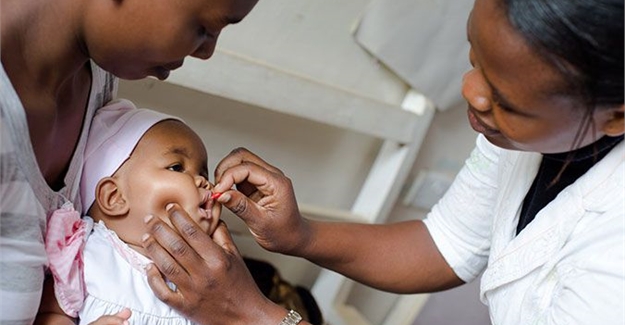Around 1.8 billion people are at heightened risk of Covid-19 and other diseases because they use or work in health care facilities without basic water services, the World Health Organization (WHO) and the United Nations Children's Fund (UNICEF) has said in a report.
The report - Global progress report on WASH in health care facilities: fundamentals first - comes as Covid-19 is exposing key vulnerabilities within health systems, including inadequate infection prevention and control.
Water, sanitation, and hygiene (WASH) are vital to the safety of health workers and patients yet provision of these services is not prioritized.
Worldwide, one in four health care facilities has no water services, one in three does not have access to hand hygiene where care is provided, one in 10 has no sanitation services, and one in three does not segregate waste safely.
The situation is worst of all in the world's 47 least developed countries (LDCs): one in two health care facilities does not have basic drinking water, one in four health care facilities has no hand hygiene facilities at points of care, and three in five lack basic sanitation services.
The report's preliminary estimates indicate that it would cost roughly one U.S. dollar per capita to enable all 47 LDCs to establish basic water service in health facilities.
On average, 0.20 dollars per capita is needed each year to operate and maintain services.
According to the report released on Monday, immediate, incremental investments in WASH have big returns: improving hygiene in health care facilities is a "best buy" for tackling antimicrobial resistance.
It reduces health care costs because it reduces health-care-associated infections (which are costly to treat).
It saves time as health workers do not have to search for water for hand hygiene. Better hygiene also increases the uptake of services.
This all adds up to a return of 1.5 U.S. dollars for every dollar invested. These services are especially critical for vulnerable populations, including pregnant mothers, newborns, and children.
Improving WASH services in health care facilities is particularly important around childbirth when far too many mothers and newborns suffer and die, including from preventable conditions like sepsis.
Better WASH services could save a million pregnant women and newborns' lives and reduce still-births.
The report provides four main recommendations, which include implementing costed national roadmaps with appropriate financing and monitoring and regularly reviewing progress in improving WASH services, practices and the enabling environment.
Global WASH and health partners have shown their support for meeting global and country WASH in health care facility targets. By 2020, over 130 partners have committed resources, of which 34 have made dedicated financial commitments totaling 125 million dollars.
Nevertheless, implementation of the 2019 World Health Assembly Resolution on WASH in health care facilities is uneven.
Of the nearly 50 countries for which WHO and UNICEF have data, 86 percent have updated standards and 70 percent have conducted initial assessments which show that these areas are generally on track.
Yet just a third of countries have costed national WASH in health care facility roadmaps and only 10 percent have included WASH indicators in national health systems monitoring.
More catalytic global funding, technical support, and domestic resourcing is needed to keep health care workers and patients safe and protected.
An opportunity exists to build on existing efforts and commitments and integrate WASH in health care facilities in all national COVID-19 plans, vaccine distribution and economic recovery packages.
Data published by WHO in October indicate that COVID-19 infections among health care workers are far greater than those in the general population: Health care workers represent less than three cent of the population, but account for 14 percent of global COVID-19 cases reported to WHO.
The data in this year's report include statistics for 165 countries, from surveys representing 760,000 facilities.
Compared to last year's baseline report, estimates were available for 125 countries with data from surveys representing 560,000 facilities.
The data on county progress in implementing the World Health Assembly Resolution represent 47 countries. It is the first time these data have been compiled and analyzed.
Latest Stories
-
Town council in Canada at standstill over refusal to take King’s oath
16 mins -
Trump picks Pam Bondi as attorney general after Matt Gaetz withdraws
28 mins -
Providing quality seeds to farmers is first step towards achieving food security in Ghana
39 mins -
COP29: Africa urged to invest in youth to lead fight against climate change
2 hours -
How Kenya’s evangelical president has fallen out with churches
2 hours -
‘Restoring forests or ravaging Ghana’s green heritage?’ – Coalition questions Akufo-Addo’s COP 29 claims
2 hours -
Give direct access to Global Health Fund – Civil Society calls allocations
4 hours -
Trudeau plays Santa with seasonal tax break
4 hours -
Prince Harry jokes in tattoo sketch for Invictus
4 hours -
Akufo-Addo commissions 200MW plant to boost economic growth
4 hours -
Smallholder farmers to make use of Ghana Commodity Exchange
4 hours -
I want to focus more on my education – Chidimma Adetshina quits pageantry
5 hours -
Priest replaced after Sabrina Carpenter shoots music video in his church
5 hours -
Duct-taped banana artwork sells for $6.2m in NYC
5 hours -
Arrest warrants issued for Netanyahu, Gallant and Hamas commander over alleged war crimes
5 hours

